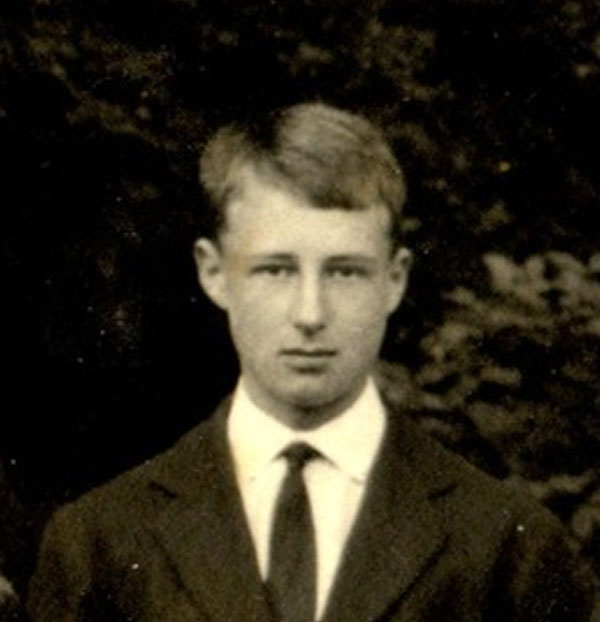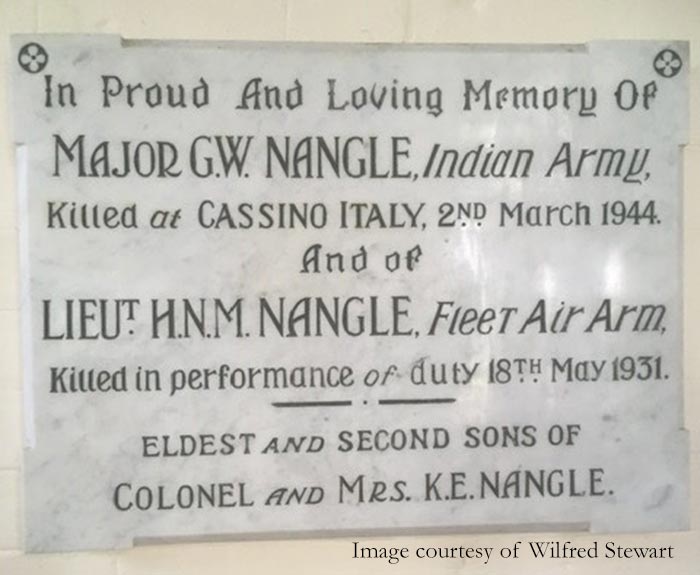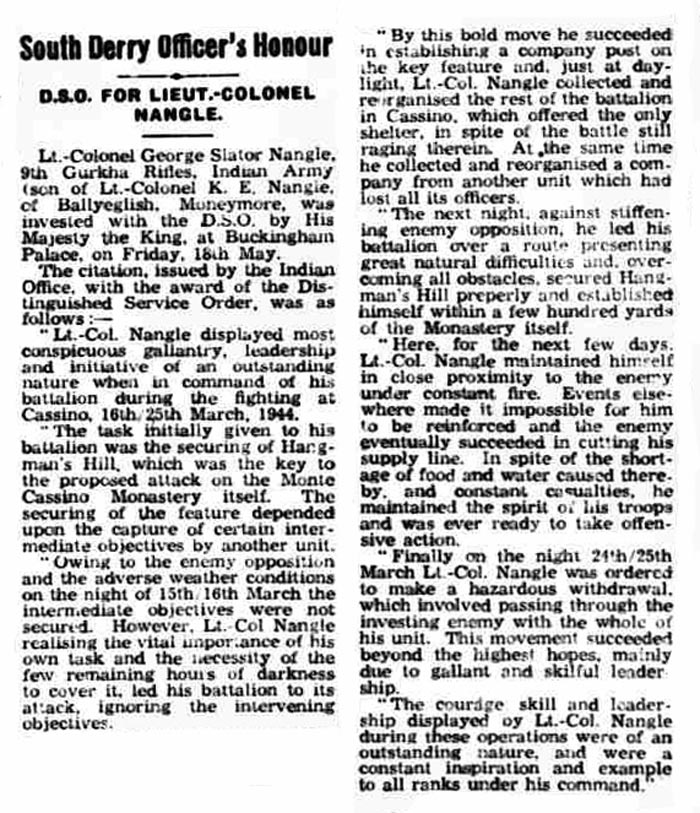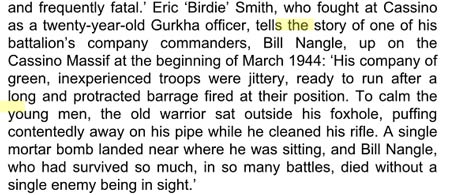 |
|
|
| Date |
Information |
|
| 03/06/2024 |
 |
| 16/10/2020 |
Many thanks to Wilfred Stewart who supplied the image of the tablet. |
| 16/10/2020 |
In proud and loving memory of Major G W Nangle, Indian Army. Killed at Cassino, Italy on 2nd March 1944. And of Lieutenant H N M Nangle, Fleet Air Arm, killed in performance of duty on 18th May 1931. Eldest and second sons of Colonel and Mrs K E Nangle. |
| 16/10/2020 |
 |
| 16/10/2020 |
There is memorial tablet in Ballyeglish Parish Church commemorating Major Gilbert Nangle. It reads: |
| 10/10/2020 |
Lieutenant Milo Nangle, whose name is a also recorded, was a typical sailor, a very simple happy natured young man, who always brought sunshine, wherever he went. He was killed in 1931, through no fault of his own, in a collision between two planes when a number were landing in formation on Aircraft Carrier Courageous. |
| 10/10/2020 |
The preacher in St Matthias’s Church, Ballyeglish on Sunday morning was His Grace the Lord Primate. The service was conducted by the rector, Rev R C C O’Connor. M.A., and the Sacrament of the Lord’s Supper was celebrated by the Archbishop. Miss F McCutcheon presided at the organ. His Grace the Lord Primate unveiled a tablet in the memory of Major Gilbert William Nangle and Lieutenant Milo Nangle, sons of Colonel and Mrs K E Nangle of Ballyeglish Major Gilbert William Nangle, who lost his life in Italy, joined the Indian Army in 1923 and served on the Frontier and in other parts of India. After some years he submitted his resignation, as peacetime soldiering did not appeal to him, although he was much beloved by his men. Later he received a commission in the Palestine police. Here he had more scope for the life of adventure for which he craved. But on the outbreak of war the call to arms was too strong to resist, and he got leave to re-join the Indian Army. He was employed on intelligence work for a time in Iraq, but when the Indian Long Range Desert Squadron was formed, he volunteered for it and after a course of training went with it to North Africa at the beginning of 1942. The squadron was used for recognisance and demolition work, and generally operated miles behind enemy lines, making its way across the uncharted desert by navigation. For his share in this dangerous and arduous he was mentioned id despatches. When the Germans were drive out of North Africa, he volunteered for Italy, and was appointed to the 2/7th Ghurkha Rifles. They were sent to help in the taking of Cassino town and monastery, and in the fighting there he met his death. |
| 10/10/2020 |
 |
| 10/10/2020 |
From the Mid Ulster Mail dated 30th June 1945: Ballyeglish Parish – Memorial Tablets Unveiled |
| 03/10/2020 |
 |
| 03/10/2020 |
From the Mid Ulster Mail dated 26th May 1945: South Derry Officer’s Honour – D.S.O. for Lieutenant Colonel George Slator Nangle (brother of Major Gilbert Nangle) |
| 03/10/2020 |
Lieutenant Colonel George Slator Nangle, 9th Ghurkha Rifles, Indian Army, son of Lieutenant Colonel K E Nangle, of Ballyeglish, Moneymore, was invested with the Distinguished Service Order (D.S.O.), by His Majesty the King at Buckingham Palace on Friday 19th May. The citation, issued by the Indian Office, with the award of the Distinguished Service Order, was as follows: |
| 03/10/2020 |
‘Lieutenant Colonel Nangle displayed most conspicuous gallantry, leadership and initiative of an outstanding nature when in command of his battalion during the fighting at Cassino between 16th and 25th March 1944. The task initially given to his battalion was the securing of Hangman’s Hill, which was the key to the proposed attack on the Monte Cassino monastery itself. The securing of the feature depended upon the securing of certain intermediate objectives by another unit. Owing to the enemy opposition and the adverse weather conditions on the night of 15th-16th March, the intermediate objectives were not secured. However, Lieutenant Colonel Nangle, realising the vital importance of his own task and the necessity of the few remaining hours of darkness to cover it, led his battalion to his attack, ignoring the intervening objectives. |
| 03/10/2020 |
By this bold move, he succeeded in establishing a company post on the key feature and just at daylight, Lieutenant Colonel Nangle collected and reorganised the rest of the battalion in Cassino, which offered the only shelter, in spite of the battle still raging therein. At the same time he collected and reorganised a company from another unit which had lost all its officers. The next night, after stiffening enemy opposition, he led his battalion over a route presenting great natural difficulties and, overcoming all obstacles, secured Hangman’s Hill properly and established himself within a few hundred yards of the monastery itself. Here, for the next few days, Lieutenant Colonel Nangle maintained himself in close proximity to the enemy under constant fire. Events elsewhere made it impossible for him to be reinforced and the enemy eventually succeeded in cutting his supply line. In spite of the shortage of food and water caused thereby, and constant casualties, he maintained the spirit of his troops and was ever ready to take offensive action. Finally, on the night of 24th-25th March, Lieutenant Colonel Nangle was ordered to make a hazardous withdrawal, which involved passing through the investing army with the whole of his unit. This movement succeeded beyond the highest hopes, mainly due to gallant and skilful leadership. The courage, skill and leadership displayed by Lieutenant Colonel Nangle during these operations were of an outstanding nature and were a constant inspiration and example to all ranks under his command.’ |
| 01/07/2020 |
 |
| 30/06/2020 |
Colonel K E Nangle, J.P., and Mrs Nangle of Ballyeglish, Moneymore, has received intimation that their eldest son, Major G W Nangle, of the Gurkha Rifles, has been killed in action. Major Nangle was educated at Sedbergh School and the Royal Military College, Camberley. He received his commission in the Indian Army in 1923 and served in India until 1934, when he sent in his resignation. Peace-time soldiering did not appeal to him and the government were cutting down the Army and anxious for officers to retire. He then fought as a volunteer in the Spanish Civil War in 1936, and in 1938 was given a commission in the Palestinian Police Force. But in 1941 the call to arms was too strong for him to resist and he sent in his resignation, which was accepted with regret by the Chief Commissioner. He was again given a commission in the Indian Army. When volunteers where asked for to join the Indian Long Range Squadron, he put in for it and went to North Africa early in 1942. A war correspondent has written of this unit:- ‘It’s history is an epic which as still to be told.’. it was used for recognisance and demolition work and often operated mils behind the German and Italian lines, finding a way through the desert by navigation. Its work in Africa was finished in the summer of 1943, and shortly afterwards Captain Nangle (as he then was) joined the Gurkha Rifles, where he was quickly promoted. His regiment, which already had a splendid record in this war, was lately sent to Central Mediterranean Force, where it is seeing heavy fighting. Another of Colonel and Mrs Nangle’s sons, lieutenant Colonel G S Nangle, is commanding a battalion of the Gurkhas. |
| 30/06/2020 |
 |
| 30/06/2020 |
From the Mid Ulster Mail dated 18th March 1944: Moneymore Officer Killed – Major G W Nangle |
| 30/12/2015 |
He next became a student at the Royal Veterinary College at Edinburgh, but abandoned his studies. Then for a period he went into a partnership running a riding school at Buckinghamshire. |
| 30/12/2015 |
When he went back to India he rejoined his regiment and moved with it to Ahmednagar. However, he was unable to settle down to routine peacetime soldiering, and in 1934, he resigned his commission. |
| 30/12/2015 |
After some eighteen months with them, he rejoined his regiment in Waziristan on the Northwest Frontier before returning to Ireland in 1933, for a second period of furlough. |
| 30/12/2015 |
Back in India, he next spent some time with his regiment at Fyzabad before being seconded to the Eastern Frontier Rifles, an armed police unit engaged in anti-terrorist operations in East Bengal. |
| 30/12/2015 |
In 1928, he came home to Ireland on leave. Towards the end of this leave, he went to Dunkirk and enlisted in the French Foreign Legion in the mistaken belief that he would obtain his discharge as soon as he disclosed that he was a serving officer in the Indian Army. However, when he reached the depot at Sidi-bel-Abbes in Algeria, he was soon disabused of that illusion. After completing his preliminary training there he was posted to the 1st Regiment Etranger at Saida. In the meantime his parents had brought his case to the notice of the authorities at the highest level and largely due to his mother’s determined persistence had enlisted the active support of the Secretary of State for War and the sympathetic interest of Edward, Prince of Wales. As a result the French authorities eventually agreed to release him in May 1930. |
| 30/12/2015 |
For the next four years his life was typical of the Northwest Frontier and at Fyzabad in the United Provinces with an occasional period of leave which he spent at shooting in out of the way parts of the country. |
| 30/12/2015 |
In 1924, he went out to India, and after a year’s attachment to the 1st Battalion of the Duke of Cornwall’s Light Infantry at Lucknow, joined his Indian army unit, the 3rd Battalion, 7th Rajput Regiment (The Duke of Connaught’s Own) at Landi Kotal at the head of the Khyber Pass. |
| 30/12/2015 |
He then went to Wychwood Preparatory School in Bournemouth, which for three years was also home for his younger brothers Milo and George. Their parents remained in India. |
| 30/12/2015 |
Gilbert spent the greater part of his early boyhood in India until he was nearly seven years old. |
| 30/12/2015 |
When the Spanish Civil War broke out, he and a friend, who had served as an officer in the Irish Guards, went to Spain via Portugal and were interviewed by General Franco at his headquarters at Caracus. They were given commissions as lieutenants in the Spanish Foreign Legion. Gilbert was now posted to the 5th Bandera of the legion and on the 10th of September 1936. He joined the column under Major (later a general) Castejon Espinosa. He immediately became involved in the fighting in the Battle of El Casa de Escalona in which he distinguished himself and was subsequently mentioned in a citation in Orders for the Day. For the next two years, with the exception of a period in 1937 when he was attached as a liaison and training officer to O’Duffy’s Irish Brigade. He was actively engaged in the often fierce fighting of the civil war including the relief of the Alcazar at Toledo and the advance on and subsequent siege of Madrid. He was twice seriously wounded, the second time resulting in his being granted indefinite sick leave, as a result of which he returned to Ireland early in 1938. |
| 30/12/2015 |
‘His company of green inexperienced troops were jittery, ready to run after a long and protracted barrage fired at their position. To calm the young men, the old warrior sat outside his foxhole, puffing contentedly away on his pipe while he cleaned his rifle. A single mortar bomb landed near where he was sitting, and Bill Nangle, who had survived so much, in so many battles, died without a single enemy in sight.’ |
| 30/12/2015 |
From there he went to Sedbergh and later to the Royal Military College, Sandhurst. |
| 30/12/2015 |
At the end of the summer of 1938 he was commissioned into the Palestine Police and spent the next two and a half years with them in Palestine being in active operations as a result of the Arab rebellion. |
| 30/12/2015 |
The 1939-45 war, having broken out, he rejoined the army in April 1941, serving for a short time with the “Palestine Buffs” before being transferred back to the Indian Army. |
| 30/12/2015 |
Early in 1942, he joined the recently formed Indian Long Range Squadron and served with it as part of the Long Range Desert Group in North Africa until after the fall of Tunisia in 1943. For his service during this period he was mentioned in dispatches. |
| 30/12/2015 |
During the winter of 1943-44, he joined the 2nd Battalion, 7th Gurkha Rifles which was being formed in Lebanon. He went with them to Italy and was soon involved in heavy fighting at Cassino. |
| 30/12/2015 |
During the early months of 1944, Cassino witnessed some of the fiercest fighting of the Italian campaign. The town of Cassino and the dominating Monastery Hill proved the most stubborn obstacles encountered in the advance towards Rome. |
| 30/12/2015 |
It was there that he was killed at the age of forty-one on the 2nd March 1944. He was buried in the Cassino War Graves Cemetery, Gurkha Section.. |
| 30/12/2015 |
His parents lived at Ballyeglish Rectory, Moneymore, County Londonderry. Colonel Nangle worshipped at Ballyeglish parish church and read the lesson every Sunday. During World War 2 he was the Commanding Officer with Ballyeglish Home Guard. |
| 30/12/2015 |
Major Gilbert Nangle was remembered around Ballyeglish. When he came home on leave he would often take in long walks around the area. |
| 30/12/2015 |
The CWGC record Major Gilbert Nangle as the son of Colonel Kenlis E. Nangle, Indian Army, and Sybel B. Nangle, of Portstewart, Co. Londonderry, Northern Ireland. |
| 30/12/2015 |
Gilbert William Nangle was the son of Kenlis E. and Sybil B. Nangle. Gilbert was born at Aurangabad, India on 2nd October 1902. |
| 30/12/2015 |
Eric Birdie Smith, who fought at Cassino as a twenty one year old Gurkha officer, tells the story of one of his battalion’s company commanders, Bill Nangle, who was up on Cassino Massif at the beginning of March 1944. |
| 30/12/2015 |
 |
| 30/12/2015 |
From the book Monte Cassino by Matthew Parker: |

|
|